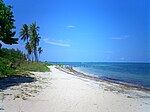MAST Academy

Maritime and Science Technology Academy, commonly referred to as MAST Academy, or MAST, is a public high school in Miami, Florida, on Virginia Key. MAST Academy is a magnet school under the governance of Miami-Dade County Public Schools. The school's principal is Dr. Cadian Collman-Perez. U.S. News & World Report ranked MAST as the 42nd best high school in the nation as of 2015.The academic focus of MAST Academy is primarily marine studies. Students choose one of three major areas of study in which a traditional U.S. high school curriculum is infused with maritime-related subjects. These areas are Oceanic and Atmospheric Sciences (OAS), Maritime Studies and Culture (MSC), and Marine Related Industries (MRI). Special course offerings include Marine Science, Oceanography, Solar Energy, Environmental Science, Swimming, and Water Safety. MAST Academy is located on Virginia Key, a barrier island between Miami and Key Biscayne, across the street from the Miami Seaquarium and within walking distance of the University of Miami Rosenstiel School of Marine and Atmospheric Science.
Excerpt from the Wikipedia article MAST Academy (License: CC BY-SA 3.0, Authors, Images).MAST Academy
Rickenbacker Causeway,
Geographical coordinates (GPS) Address Website External links Nearby Places Show on map
Geographical coordinates (GPS)
| Latitude | Longitude |
|---|---|
| N 25.7388889 ° | E -80.1663889 ° |
Address
Mast Academy
Rickenbacker Causeway 3979
33149
Florida, United States
Open on Google Maps






